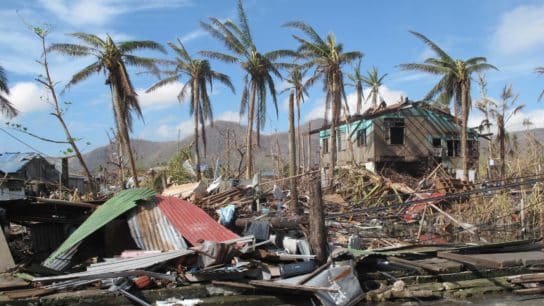Last year, the city saw 35 record-breaking high temperature events, including the highest absolute maximum temperature for March, the warmest April on record, the warmest first half-year on record, and the highest number of hot nights for August.
—
In line with the global trend, Hong Kong just recorded its hottest year since at least 1884, when the city first began tracking temperature trends.
The annual mean temperature stood at 24.8C, 1.3 degrees above the 1991-2020 normal, according to the Hong Kong Observatory’s yearly climate report published Monday. The annual mean minimum temperature and annual mean maximum temperature were respectively the highest and second highest on record.
September 17 saw the highest daily temperature of the year at 35.7C, one of the eighth highest on record, the Observatory said.
35 Temperature Records
In 2024, Hong Kong saw a total of 35 record-breaking high temperature events. These included the highest absolute maximum temperature on record for March at 31.5C, the warmest April on record with temperatures significantly above normal, the warmest first half-year on record, and the highest number of hot nights for August.
A weaker northeast monsoon also made October warmer than any other October on record, and the warmest autumn from September to November, according to Monday’s report.

These high temperatures were attributed to various factors like warmer sea surface temperatures, stronger southerly flows, and weaker monsoon patterns, according to the city’s Observatory.
Global sea surface temperatures remained at record highs from January to June last year. In the latter half of 2024, the temperatures were the second-warmest on record for that time of year, after 2023.
Hotter Days, Hotter Nights
“There were 52 Very Hot Days, 50 Hot Nights and two Extremely Hot Days in Hong Kong in 2024, respectively ranking one of the third highest, one of the fourth highest and one of the eighth highest on record,” the Observatory said on Monday.
For people living in places like Hong Kong, summer heat is nothing new. In the city, temperatures soar above 30C (86F) for most part of the year, which feel even higher when coupled with high humidity levels. Yet, heat-related illnesses here are on the rise.
A study conducted by researchers at the University of Hong Kong and published last year found that heatwaves in the city over the past decade, 18 in total, may have contributed to 1,677 excess deaths.

As of 2022, Hong Kong had already warmed 1.7C compared to pre industrial times and is on track for 3.4C of warming by the end of the century, according to independent climate research organization Berkley Earth.
The increase in extreme heat is a direct result of our warming planet, which is driven by greenhouse gasses that trap heat in the atmosphere. This raises Earth’s surface temperature, leading to longer and hotter heatwaves.
Prolonged exposure to high temperatures without sufficient rest or cooling breaks can result in heat exhaustion – with symptoms including heavy sweating, weakness, dizziness – and heatstroke – which is marked by a high body temperature, confusion, and loss of consciousness. It can be life-threatening if not promptly treated.
But in a rapidly warming world, another issue is emerging: nighttime heat.
High nighttime temperatures are detrimental to human health, as they prevent the body from recovering from daytime heat. This not only disrupts sleep, which can negatively affect physical and mental health, cognitive function, and life expectancy, but it also increases the risk of illness and mortality.
A 2020 study by the Chinese University of Hong Kong (CUHK) found that five consecutive “hot nights,” defined as when temperatures rise above 28C (82F), would raise the risk of death by 6.66%.
With climate change, nights are not just getting warmer; they are also heating up faster than days in many parts of the world. According to a Climate Central analysis published last year, between 2014 and 2023, 2.4 billion people experienced an average of at least two additional weeks per year where nighttime temperatures exceeded 25C. Over 1 billion people experienced an average of at least two additional weeks per year of nights above 20C and 18C.
Supercharged Typhoons
29 tropical cyclones developed over the western North Pacific and the South China Sea in 2024, in line with the long-term average of about 30, and 13 of them reached typhoon intensity.
Despite issuing tropical cyclone warning signals on seven occasions, the events resulted in little to no damage in Hong Kong, contrary to places like the Philippines, Taiwan, and China.
Following a period of low tropical cyclone activity in the South China Sea in August, tropical cyclone Yagi emerged in the northern region on September 3 after wreaking havoc in the Philippines, where it killed 21 people.
Within 24 hours of its appearance, Yagi rapidly intensified from a severe tropical storm to a super typhoon. It reached its peak intensity with maximum sustained winds of 230 kilometers per hour (142 miles per hour) on September 6, marking it as the second most potent tropical cyclone in the South China Sea since 1950.
Supercharged by warmer ocean waters, tropical storms are intensifying more rapidly globally, with winds increasing by 56 km/h (about 35 miles per hour) in a 24-hour period. Rapid intensification leaves less time for authorities to issue warning systems, putting coastal communities in great danger.
Yagi’s death toll surpassed 500 people across Vietnam, Myanmar, Laos, Thailand, and the Philippines. Thousands of homes were damaged or destroyed, with Vietnam and southern China bearing the brunt.
More on the topic: What Are Tropical Cyclones? Hurricanes and Typhoons, And Their Link to Climate Change, Explained
In November, Hong Kong experienced three back-to-back tropical cyclones – Yinxing, Toraji, and Man-yi – an unusual occurrence so late in the typhoon season. This led to the issuance of tropical cyclone warning signals for all three episodes, a first for November since 1946. Yinxing brought strong winds, prompting the city’s latest No. 8 Gale or Storm Signal since 1946.
Tropical cyclones – which get their energy from warm ocean water – are strengthening and become ever more destructive because of warming seas. The likelihood of storms reaching major hurricane or typhoon status has also increased significantly over the past decades.
Featured image: Kyle Lam/hongkongfp.com
This story is funded by readers like you
Our non-profit newsroom provides climate coverage free of charge and advertising. Your one-off or monthly donations play a crucial role in supporting our operations, expanding our reach, and maintaining our editorial independence.
About EO | Mission Statement | Impact & Reach | Write for us














